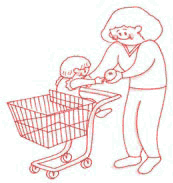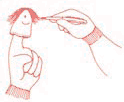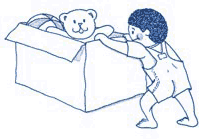|
Shop Till You Drop
Shopping for groceries is just one of many daily routines that you can use to help your child learn. Shopping is especially good for teaching your child new words and for introducing him to new people and places.
What you need:

- Pick a time when neither you nor your child is hungry or tired.
- At the grocery store, put your child in the grocery cart so that he faces you. Take your time as you walk up and down the aisles.
- Let your child feel the items that you buy - a cold carton of milk, for example or the skin of an orange. Talk to your child about the items: "The skin of the orange is rough and bumpy. Here, you feel it."
- Be sure to name the objects that you see on shelves and talk about what you are seeing and doing: "First, we're going to buy some cereal. See, it's in a big red and blue box. Listen to the great noise it makes when I shake the box. Can you shake the box? Now we're going to pay for the groceries. We'll put them on the counter while I get out the money. The cashier will tell us how much we have to pay."
- Encourage your child to practice saying "hi" and "bye-bye" to clerks and other shoppers.
- Leave for home before your child gets tired or grumpy.
Puppet Magic
Puppets are fascinating to children. They know that puppets are not alive, yet they often listen to and talk with them as if they were real.
What you need
- An old, clean sock
- Buttons (larger than 1 inch in diameter to prevent swallowing)
- Needle and thread
- Red fabric
- Ribbon
- An old glove
- Felt-tipped pens
- Glue
- Yarn
 What to Do to Make Puppets:
What to Do to Make Puppets:
- Sock puppet: Use an old, clean sock. On the toe-end of the sock, sew on buttons for eyes and nose. Paste or sew on a piece of red fabric for the mouth. Put a bow made from ribbon at the neck.
- Finger puppets: Cut off the fingers of an old glove. Draw faces on the ends of the fingers with felt-tipped pens. Glue on yarn for hair.
 Things to do with puppets:
Things to do with puppets:
- Have the puppet talk to your child: "Hello. My name is Tanya. What's yours? Kaylee. That's a pretty name. What a great T-shirt you have on, Kaylee! I like the rabbit on the front of your T-shirt." Or have the puppet sing a simple song. Use a special voice for the puppet.
- Encourage your child to talk to the puppet, answering its questions and asking questions of her own.
- Put finger puppets on your child's hand to give him practice moving his fingers one at a time.
- The next time you want your child to help you clean up, have the puppet make the request: "Hello, Max. Let's put these crayons back in the box and these toys back on the shelves. Can you get the ball for me?"
Puppets provide another opportunity for you to talk to your child and encourage him to talk to you as well. They also help your child to learn new words, use his imagination and develop hand and finger coordination. |
Moving On
Toddlers love to explore spaces and to climb over, through and into things.
What You Need

- Stuffed animal or toy
- Large board boxes
- Pillows
- A large sheet
- A soft ball
- A large plastic laundry basket
- Elastic
- Bells
What to Do
- Pillow jump. Give your child several pillows to jump into. (Toddlers usually figure out how to do this on their own.)
- Box car. Give your child a large cardboard box to push around the room. He may want to take his stuffed animal or toy for a ride in it. If the box isn't too high - you'll most likely find your toddler in the box as well.
- Basketball. Sit about 3 feet away from your child and hold out a large plastic laundry basket. Let her try throwing a large, soft ball into the basket.
- Table tent. Cover a table with a sheet that's big enough to reach the floor on all sides. This makes a great playhouse that's particularly good for a rainy day.
- Jingle bells Sew bells onto elastic that will fit comfortably around your child's ankles. Then watch (and listen) as he moves about or jumps up and down.
As you do an activity, talk, talk, talk with your child about what the two of you are doing!
Movement activities help children to gain control of their large muscles. They also help children to learn newwords
and important concepts such as locations: up, down, inside, outside, over, behind, beside and under. |
Learning Activities for Children:
|
|
|